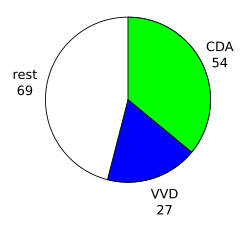Second Lubbers cabinet | |
|---|---|
Cabinet of the Netherlands | |
  The installation of the Second Lubbers cabinet on 14 July 1986 | |
| Date formed | 14 July 1986 |
| Date dissolved | 7 November 1989 3 years, 116 days in office (Demissionary from 3 May 1989) |
| People and organisations | |
| Monarch | Queen Beatrix |
| Prime Minister | Ruud Lubbers |
| Deputy Prime Minister | Rudolf de Korte |
| No. of ministers | 14 |
| Ministers removed | 1 |
| Total no. of members | 16 |
| Member party | Christian Democratic Appeal (CDA) People's Party for Freedom and Democracy (VVD) |
| Status in legislature | Centre-right Majority government |
| History | |
| Election | 1986 election |
| Outgoing election | 1989 election |
| Legislature terms | 1986–1989 |
| Incoming formation | 1986 formation |
| Outgoing formation | 1989 formation |
| Predecessor | First Lubbers cabinet |
| Successor | Third Lubbers cabinet |
| Part of the Politics series |
![Azure, billetty Or a lion with a coronet Or armed and langued Gules holding in his dexter paw a sword Argent hilted Or and in the sinister paw seven arrows Argent pointed and bound together Or. [The seven arrows stand for the seven provinces of the Union of Utrecht.] The shield is crowned with the (Dutch) royal crown and supported by two lions Or armed and langued gules. They stand on a scroll Azure with the text (Or) "Je Maintiendrai" (French for "I will maintain".)](http://upload.wikimedia.org/wikipedia/commons/thumb/8/8f/State_coat_of_arms_of_the_Netherlands.svg/150px-State_coat_of_arms_of_the_Netherlands.svg.png) |
|---|
|
|
The second Lubbers cabinet was the executive branch of the Dutch Government from 14 July 1986 until 7 November 1989. The cabinet was a continuation of the previous First Lubbers cabinet and was formed by the Christian-democratic Christian Democratic Appeal (CDA) and the conservative-liberal People's Party for Freedom and Democracy (VVD) after the election of 1986. The cabinet was a centre-right coalition and had a substantial majority in the House of Representatives with Christian-Democratic Leader Ruud Lubbers serving Prime Minister. Former Liberal Leader Rudolf de Korte the Minister of the Interior in the previous cabinet served as Deputy Prime Minister and Minister of Economic Affairs.
The cabinet served in the middle of the turbulent 1980s. Domestically it had to deal with revitalizing the economy following the Early 1980s recession, reducing the deficit and stimulating deregulation and privatization, it was able to implement several major social reforms to social security, student loans, value-added taxes, public broadcasting and further stimulating Urban development. Internationally it had to deal with several crises such as the fallout of the decision to allow NATO to place the Medium Extended Air Defense System (MEADS) at Woensdrecht Air Base. The cabinet suffered several major internal conflicts including multiple resignations, the cabinet fell 3 years into its term on 3 May 1989 following a disagreement in the coalition over a proposed excise and the cabinet continued in a demissionary capacity until it was replaced with the Third Lubbers cabinet following the 1989 election.[1][2]
- ^ (in Dutch) NRC-enquête: Drees en Lubbers beste premiers sinds 1900, NRC Handelsblad, 28 September 2013
- ^ "De jaren tachtig van Onno Ruding" (in Dutch). Historisch Nieuwsblad. 19 August 2001. Retrieved 16 February 2018.